How Does A Reverse Osmosis Filter Work

-
1. Is a Opposite Osmosis Water Filter a Proficient Filtration Pick?
-
two. What is Reverse Osmosis Water & How Does Contrary Osmosis Piece of work?
-
3. What Does Reverse Osmosis Remove?
-
four. How Does a Reverse Osmosis Membrane Work?
-
5. Are All RO Drinking Water Systems the Same?
-
half dozen. How Much Maintenance Does an RO System Crave?
-
7. RO Ofttimes Asked Questions
If you're looking for a water filter that will provide dandy-tasting, fresh drinking water for your habitation or business concern, Contrary Osmosis (RO) water filtration is 1 of the most popular and cost-effective h2o filtration methods available. In simple terms, a opposite osmosis h2o filter works as h2o is forced across a semi-permeable membrane, leaving contaminants behind that are flushed down the bleed. The make clean drinking water collects in a holding tank.
Millions of American households install Reverse Osmosis (RO) because:
- Reverse Osmosis produces healthy, slap-up-tasting h2o
- RO saves coin over a water delivery service
- Reverse Osmosis is unproblematic to install
- RO filtration is fully automated
- Contrary Osmosis uses no electricity
Below yous will find diagrams, charts and explanations to answers your questions nearly Reverse Osmosis drinking h2o systems. If you accept other questions which are non answered here, delight visit our our main water pedagogy page or Contact Us.
Nosotros've been in the water filtration business since 2003 and have found Contrary Osmosis filtration to consistently exist one of the best means to remove contaminants from tap h2o.
Why Choose
Contrary Osmosis
If you're searching for a water filtration organization that will requite you outstanding water...
Hither are a few reasons to consider RO:
1Improves Sense of taste
RO filtration improves taste, odor and appearance of h2o by removing contaminants that cause gustation and odor bug.
twoSaves Money
With an RO system, you lot tin can abolish your water commitment service and stop purchasing cases of bottled water. Reverse Osmosis filtration provides "better-than-bottled water" quality water for just pennies per gallon.
3Simple Maintenance
RO systems have very few moving or replaceable parts brand RO systems easy to clean and service.
Find out why millions of households have opposite osmosis drinking water systems Store Now
Reverse Osmosis h2o filters are the perfect solution if you're looking to meliorate the taste, odor and advent of your water. Here are some of the near common applications for RO technology:
Installed at the kitchen sink: A small RO filtration system can be installed at the kitchen tap to provide superlative-quality drinking water. This is chosen a "betoken of utilise" (POU) water filtration organization and can also connect to your fridge and water ice car. Water force per unit area is a consideration with some refrigerators, so be certain to refer to your RO system'south possessor's manual equally the force per unit area from the Reverse Osmosis unit of measurement is about two-thirds of the incoming line pressure. Related content: How to Install a Contrary Osmosis System
Will contrary osmosis remove minerals that are healthy for my body?
Tap h2o varies with each city and h2o source. Some tap water is heavy in mineral content which can affect the taste and olfactory property of water. Filtering water with a reverse osmosis system will remove the majority of minerals in h2o and greatly improve the aesthetics of drinking water. Because minerals in water are in an inorganic state that our bodies cannot assimilate, removing the minerals does not make RO-filtered water unhealthy. Keep in mind that while minerals are essential for proper health, food is the primary source of the minerals our bodies demand to be healthy--and in a grade our bodies can digest.
Should I Install a Whole-business firm Reverse Osmosis System?
A whole-house Reverse Osmosis organization (also called a POE "point of entry" arrangement) allows RO filtered h2o at all sinks, showers and appliances throughout the house. A POE arrangement ties into the main water line coming into your home and is by and large installed in the garage.
In theory, whole business firm opposite osmosis systems sound like a adept idea. Merely here are the reasons we don't typically recommend whole house RO water filters:
- Whole-firm reverse osmosis water filters can be expensive
- Whole-house RO water filter systems crave a lot of maintenance.
- Whole-house opposite osmosis consumes a lot of water
- Whole-house RO flushes a lot of filtered h2o downwardly the drain.
- Additional pre-handling and post handling will probably be needed.
- A lot of storage space is required for the large whole-firm RO system.
For more information near whole-house reverse osmosis and what whole house water filters nosotros recommend, delight read this commodity.
Commercial Reverse Osmosis Systems
Reverse Osmosis water filtration is a perfect fit for many businesses. At ESPWaterProducts.com, nosotros carry a broad multifariousness of big RO systems designed for many different commercial applications. If yous're interested in commercial reverse osmosis, please give us a call to talk through specifics: 877-377-9876.
Common Commercial Contrary Osmosis (RO) System Applications:
- Food & Beverage Manufacture
- Agriculture
- Boiler Feed
- Disaster Relief
- Environmental
- Infirmary
- Hotel
- Marine
- Military
- Mining
- Pharmaceutical
- Power & Energy
Check out more commercial RO systems
How does Reverse Osmosis Remove Contaminants?
Contrary Osmosis h2o filtration process is simple and straightforward. It is achieved by water pressure pushing tap water through a semi-permeable membrane to remove contaminants from water. This is a process in which dissolved inorganic solids are removed from a solution. This process differs from standard filtration where impurities are nerveless within the filter media. The reverse osmosis procedure pushes water through a series of filters and ultimately the clean water goes to the holding tank, and the contaminants are flushed down the bleed.
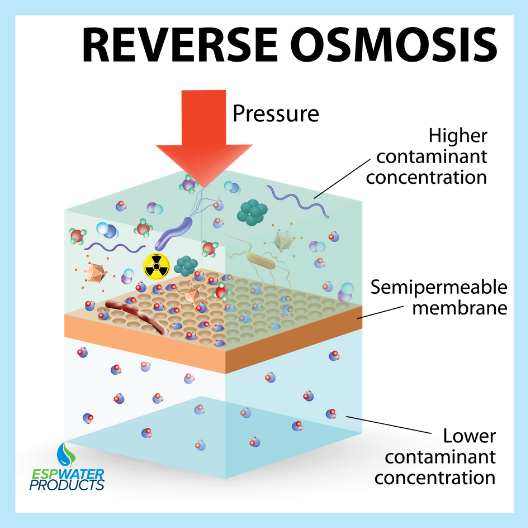
What Does Reverse Osmosis Remove:
- Fluoride
- Lead
- Chlorine & Chlormamine
- Pesticides
- Nitrates & Sulfates
- Detergents & much more
What is Reverse Osmosis Water?
When household water pressure pushes water through the RO membrane and additional filters, such as sediment or carbon filters, the impurities are filtered out and subsequently flushed downward the drain. What is left, is succulent, make clean-tasting drinking water. Notation that many RO units incorporate a 4 or 5-phase process for optimal water quality.
You may be interested to know that Reverse Osmosis technology is not new. In fact, RO processes began being utilized by municipalities back in 1977. Since and then, Reverse Osmosis has go increasingly pop because it is safe, price-constructive, and piece of cake to maintain.
Where is a Reverse Osmosis System Stored?
Mostly, an RO organization is installed and stored under the kitchen sink. Under-counter reverse osmosis systems have a belongings tank and several phases of filtration. Here'southward what happens during the reverse osmosis process of most systems:
Stage One:This is a pre-filtration phase designed to protect the unit's membranes by reducing fine, suspended materials that tin clog the system.
Phase Two: The second phase involves filtration to remove chlorine since chlorine can damage thin picture-textile membranes.
Phase 3:This is a semi-permeable membrane designed to remove a wide variety of both artful and health-related contaminants. The h2o goes from hither into a pressurized storage tank to hold the treated water.
Phase Iv: The last stage in the RO procedure is usually a carbon post-filtration phase that volition remove any remaining aesthetic gustation or odors --a "polishing stage", if you will.
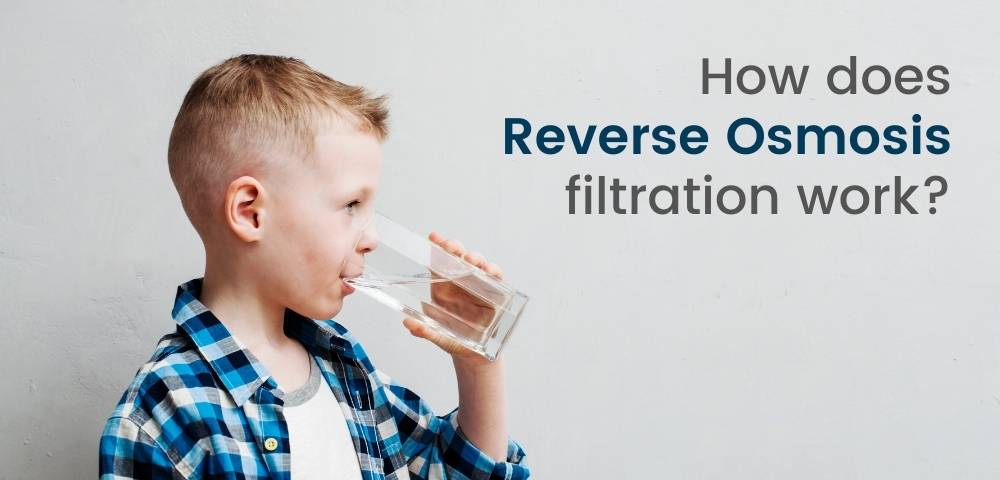
What are the basic components of a Contrary Osmosis System?
Generally, residential "Bespeak Of Utilize" POU RO systems are installed and stored nether the kitchen sink. Regarding the mutual components of a iv to five-phase RO system, note that:
- Most RO systems await similar and have the same basic components.
- Although near RO systems look and work basically the aforementioned way --they differ in the QUALITY of their components.
Basic Components of a Reverse Osmosis Organisation:
- Common cold Water Line Valve: Valve that fits onto the common cold water supply line. The valve has a tube that attaches to the inlet side of the RO pre filter. This is the h2o source for the RO organisation.
- Pre-Filter(southward): Water from the cold water supply line enters the Reverse Osmosis Pre Filter start. In that location may be more than one pre-filter used in a Opposite Osmosis system, the most common being sediment and carbon filters. These pre-filters are used to PROTECT the RO membranes by removing sand silt, dirt, and other sediment that could clog the system. Additionally, carbon filters may be used to remove chlorine, which tin damage the RO membranes.
- Contrary Osmosis Membrane: The Reverse Osmosis Membrane is the center of the system. The semipermeable RO membrane is designed to remove a wide variety of both artful and health-related contaminants. After passing through the membrane, the h2o goes into a pressurized storage tank where treated water is stored.
- Post filter(southward): Later the water leaves the RO storage tank, but before going to the RO faucet, the treated h2o goes through a terminal "post filter". The post filter is usually a carbon filter. Any remaining tastes or odors are removed from the product h2o by post filtration "polishing" filter.
- Automatic Shut Off Valve (SOV): To conserve h2o, the RO system has an automatic close off valve. When the storage tank is full, the automated close off valve closes to terminate any more than water from entering the membrane and blocks flow to the drain. One time h2o is drawn from the RO faucet, the pressure in the tank drops; the close off valve then opens to send the drinking h2o through the membrane while the contaminated wastewater is diverted down the drain.
- Check Valve: A cheque valve is located in the outlet end of the RO membrane housing. The cheque valve prevents the backward menstruum of treated water from the RO storage tank. A backward flow could rupture the RO membrane.
- Flow Restrictor: Water flowing through the RO membrane is regulated by a flow restrictor. In that location are many different styles of flow controls, but their common purpose is to maintain the flow rate required to obtain the highest quality drinking water (based on the gallon capacity of the membrane). The menses restrictor also helps maintain pressure level on the inlet side of the membrane. Without the additional pressure level from the flow control, very petty drinking water would exist produced because all the incoming water would take the path of least resistance and merely flow downwards the bleed line. The menstruum command is nearly often located in the RO drain line tubing.
- Storage Tank: The standard RO storage tank holds from two - 4 gallons of water. A bladder inside the tank keeps water pressurized in the tank when it is full. The typical under counter Contrary Osmosis tank is 12 inches in diameter and 15 inches tall.
- Faucet: The RO unit comes with a faucet, which is installed at the kitchen sink. Some areas have plumbing regulations requiring an air gap faucet, merely non-air gap models are more than common. Designer faucets are also available to compliment your kitchen decor.
- Bleed line: This line runs from the outlet end of the Reverse Osmosis membrane housing to the drain. The bleed line tubing is used to dispose of the wastewater containing the impurities and contaminants that have been filtered out by the reverse osmosis membrane.
Diagram of a Opposite Osmosis Organisation with Basic Components:
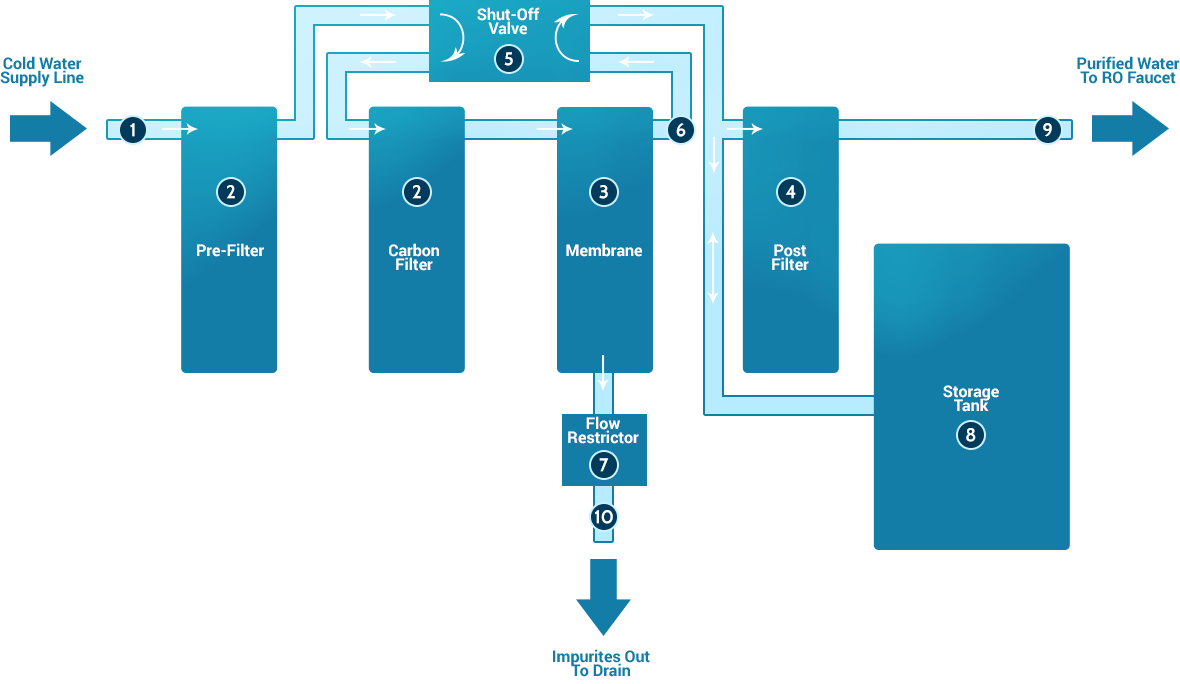
BEST Opposite Osmosis Filter Systems
At ESP Water Products, we've been selling water filtration equipment for 18+ years. This longevity in the industry has fabricated us very selective in what we sell and endorse. We carry merely Reverse Osmosis systems that have won our confidence--those that are manufactured with the highest-quality components, offer outstanding warranties, and have the highest ratings for customer satisfaction.
Best Reverse Osmosis Drinking Water Systems of 2021:
50 GPD Opposite Osmosis Arrangement
Hydro Baby-sit HDGT

- Quick-Change No-Mess Replacement Filters Under Sink
- Meaty Size for Simple Installation Under Sink
- l Gallon Per Day Rated Membrane
- 4-Stages of Filtration
- Fabricated in U.s.a.
- Free Aircraft
100 GPD Opposite Osmosis Organisation
Watts Kwik Modify iv-Stage

- Quick-Change No-Mess Replacement Filters
- 100 Gallon Per Day Rated Membrane
- 4-Stages of Filtration
- Designer Faucet
- Space-Saver Storage Tank Only 9" Wide
- FREE Aircraft
Retail $549.00
Auction $433.05 View Now
l GPD Reverse Osmosis Organization
PureValueRO 5EZ50
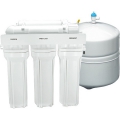
- Stardardized Blueprint for Customization and Cheaper Operation
- Compact Size for Undersink Installation
- 50 Gallon Per Day Membrane
- 5-Stages of Filtration
- Made in U.s.
- FREE Shipping
Retail $275.00
Sale $228.90 View At present
Public water suppliers work difficult to provide clean water for their customers. The trouble is that at that place are many contaminants, specially those that cause taste and odor issues, which are simply not EPA regulated. These contaminants can easily penetrate aquifers, streams and rivers, bringing impurities straight to your water lines.
That'due south where Reverse Osmosis comes in. With a Reverse Osmosis filtration organization, you lot can filter out impurities and produce outstanding drinking water for your dwelling house or business concern.
How much of a contaminant tin a Opposite Osmosis arrangement remove?
- Fluoride (85-92%)
- Pb (95-98%)
- Chlorine (98%)
- Pesticides (up to 99%)
- Nitrates (60-75%)
- Sulfate (96-98%)
- Calcium (94-98%)
- Phosphate (96-98%)
- Arsenic (92-96%)
- Nickel (96-98%)
- Mercury (95-98%)
- Sodium (85-94%)
- Barium (95-98%)

Reverse Osmosis (RO) is a water treatment procedure that removes contaminants from water by using force per unit area to strength water molecules through a semipermeable membrane. During this process, the contaminants are filtered out and flushed away, leaving clean, succulent drinking water. Opposite osmosis is capable of removing up to 99 per centum of 65 unlike contaminants (come across partial list beneath), including lead, fluoride, chlorine, dissolved salts, and more.
There are generally iv stages in the opposite osmosis process:
Sediment Filter:
This pre-filter phase is designed to strain out sediment, silt, and dirt and is especially of import as the sediment filter protects dirt from getting to the frail RO membranes that can be damaged past sediment. Learn more near sediment filter.
Carbon Filter:
The carbon filter is designed to remove chlorine and other contaminants that affect the performance and life of the RO membrane likewise every bit meliorate the taste and odor of your h2o.
Reverse Osmosis Membrane:
The semipermeable RO membrane in your RO system is designed to let h2o through, but filter out almost all additional contaminants.
Polishing Filter:
In a four-stage RO Organisation, a final mail filter (carbon filter) will "shine" off the water to remove any remaining taste and odor in the water. This final filter ensures y'all'll have outstanding drinking water.
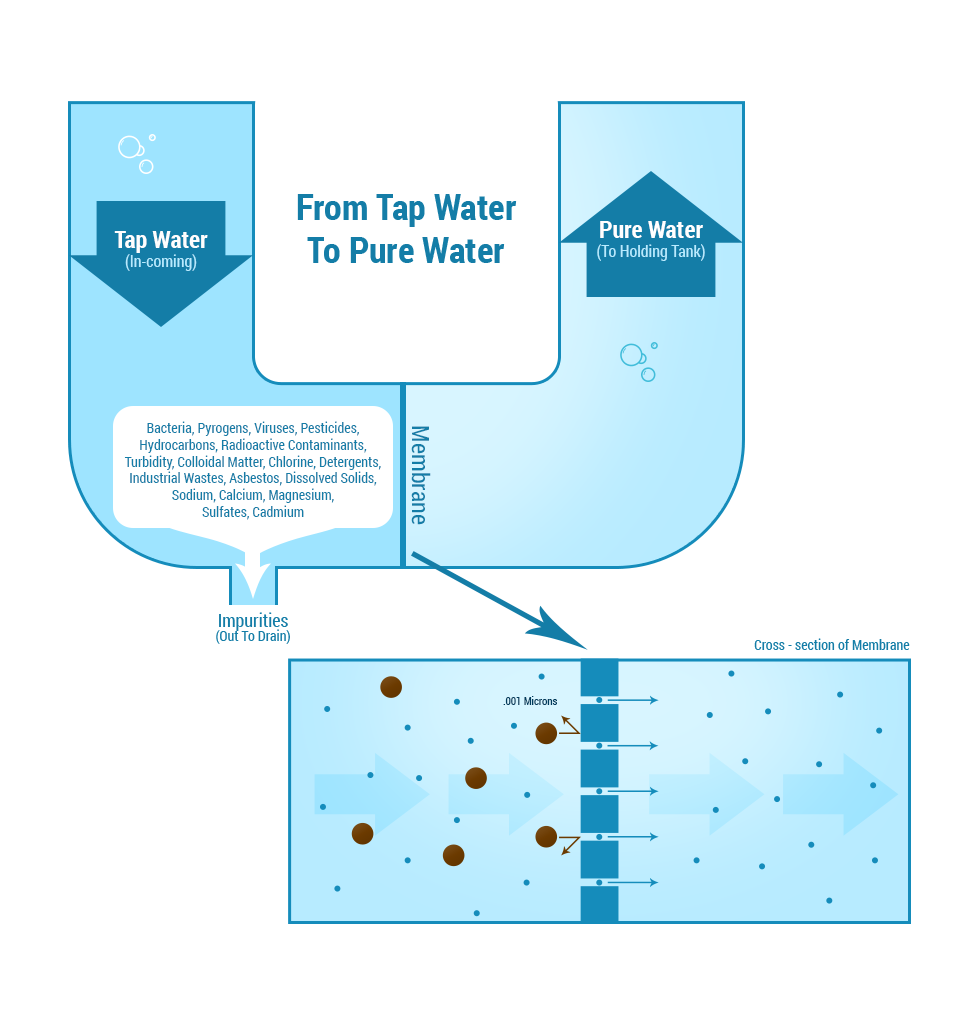
Some factors that may affect the performance of a Reverse Osmosis System:
- Incoming water pressure (almost on municipal city tap water have xl-85 psi, but if water pressure is as well low, RO organisation will not operate properly)
- Water Temperature (i.e. cold water takes longer to filter to filter)
- Blazon and number of total dissolved solids (TDS) in the tap water
- The quality of the filters and membranes used in the RO System (see operating specifications for your system)
Opposite Osmosis Membrane Operating Weather condition and Functioning Data
|
| ||||||||||||||||||
At that place are many unlike Reverse Osmosis (RO) water filtration systems on the market. While one RO System may look like the next in terms of design and components, at that place can be substantial differences between systems.
Reverse Osmosis (RO) Systems Differ in Three Bones Ways:
- Number of stages or filters
- Quality of their components
- Amount of water that tin can be filtered or produced each day (this amount is in "gpd" or gallons per twenty-four hours)
Quality components are the key to an optimal functioning RO System.
Since 2003, nosotros've institute that the quality of components is truly the key differentiation between reverse osmosis systems. This is because RO units manufactured using excellent craftsmanship, as well as superior parts and components are what ultimately produce the best intended results--superlative-quality h2o for the habitation and business organisation.
As you compare Opposite Osmosis Water filter systems to detect the product that is right for you lot, be sure to ask yourself these v questions:
- Does this system have good reviews?
- Does information technology employ quality parts from trusted manufacturers, and are the materials FDA or NSF (National Sanitation Foundation) canonical?
- Is the technology up-to-date?
- Some systems have college contaminant rejection abilities. How does this one compare to others like it?
- Read upward on the company. Is it reputable?
Best Reverse Osmosis Systems for the Home:
l GPD Reverse Osmosis System
Hydro Guard HDGT-45

- Quick-Change No-Mess Replacement Filters Under Sink
- Compact Size for Elementary Installation Nether Sink
- 50 Gallon Per Day Rated Membrane
- 4-Stages of Filtration
- Fabricated in USA
- Free Shipping
Retail $399.92
Sale $259.00 View At present
100 GPD Reverse Osmosis System
Watts Kwik Change 4-Stage

- Quick-Change No-Mess Replacement Filters
- 100 Gallon Per Day Rated Membrane
- 4-Stages of Filtration
- Designer Faucet
- Infinite-Saver Storage Tank Only 9" Wide
- Complimentary Shipping
Retail $549.00
Sale $433.05 View Now
l GPD Reverse Osmosis Organisation
PureValueRO 5EZ50

- Standardized Blueprint for Customization and Cheaper Operation
- Compact Size for Under sink Installation
- 50 Gallon Per Day Membrane
- five-Stages of Filtration
- Made in U.s.a.
- Costless Shipping
Retail $275.00
Sale $228.90 View At present
If properly maintained, a reverse osmosis drinking water system can last for many years. Proper maintenance will likewise ensure you continually have loftier-quality drinking water and effective water output. We recommend following the specific maintenance instructions for your RO system, simply provide detailed RO maintenance instructions here.
Equally a general rule, here are three things you can do to maintain (and increase the lifespan) of your reverse osmosis arrangement:
one. Change Filters
Replacing the RO membrane and filters on schedule is the most important aspect of maintaining your reverse osmosis arrangement.
RO membranes and filters will go clogged and foul with fourth dimension. When this happens, the RO system will begin to produce less and less drinking water. How often you should change the filters will vary based on water usage and local water weather.
Generally, RO replacement filters should be installed based on the following schedule:
- Pre-filters (sediment and carbon filters): Replace every 6-12 months
- Contrary Osmosis Membrane: Supersede every 24 months
- Post filter (GAC polishing filter): Replace every 12 months
This guideline is very general. Specific information about how often your RO membrane and filters should exist replaced can be constitute in the production possessor's manual for each system. If you've purchased your RO drinking water organization or replacement filters from us here at ESP Water Products, nosotros will send reminder emails when it comes time to change your filter.
We highly recommend that you purchase elevation-quality replacement filters that are designed for optimal performance and reliability. To help our customers, we transport reminder emails so thye'll know exactly when information technology's fourth dimension to change out the filters or membrane.
Note: Some name brand Reverse Osmosis systems such as Culligan and Rainsoft require expensive proprietary filter replacements. An RO "retrofit" kit allows you to keep your existing RO tank and faucet, but install a new manifold so that going forrard, you can have delicious, clean filtered drinking water, without the high price of proper noun-brand filters. Our high-quality compatible filters are guaranteed to meet the performance of proprietary filter.
two. Sanitize System
A opposite osmosis drinking water system should exist cleaned, sanitized and recharged annually. To simplify things we recommend sanitizing your arrangement when you change out your filters. Detailed instructions on how to sanitize an RO organization are available here. You can hire a local h2o treatment professional to clean and sanitize your system or you lot can perform the annual sanitation and filter alter yourself. Detailed filter replacement instructions are provided here.
iii. Supplant Parts
The various parts on a reverse osmosis system (such every bit the storage tank or faucet) will wear out with time. We provide an RO troubleshooting guide to help you diagnose the outcome and decide which part needs to be replaced. Likewise, RO function replacement recommendations may be listed in your RO system'due south owner's transmission.
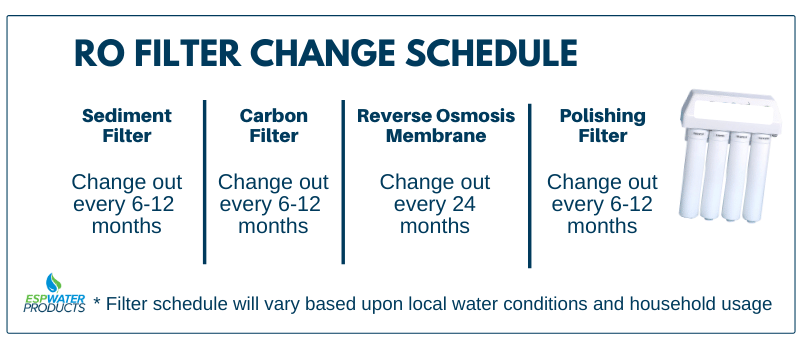
Shop for Replacement Filters Shop RO Faucets Shop RO Membranes Shop Residential RO Systems
one. Can an RO system be continued to my fridge or water ice machine?
Nether-the-counter contrary osmosis systems are plumbed to the incoming cold water line, drain, and an contained faucet. But it is possible for a water handling professional to plumb an RO unit to your fridge and/or ice machine, as well.
The water professional volition most likely run a quarter-inch tube from the under-sink RO unit to your refrigerator. H2o pressure is a consideration with some refrigerators, so be sure to refer to your RO system's owner'southward manual equally the pressure level from the contrary osmosis unit is about two-thirds of the incoming line pressure.
2. How much h2o can an RO system produce each day?
The typical nether-counter reverse osmosis tank is 12 inches in diameter and 15 inches tall. The opposite osmosis system volition operate under water pressure ranging from 40 to 100 psig and generate x to 75 gallons (that'south 45-340 Liters) per day.
iii. Is a Reverse Osmosis Organisation Noisy?
Generally, reverse osmosis systems are very serenity-- though you may hear a "gurgling" audio equally the "concentrate" or waste water flows from the membrane to the drain. Contrary osmosis is designed then that "crossflow" h2o flushes the contaminated concentrate abroad from the system. This flushing keeps the unit of measurement from fouling.
If you hear other sounds, such as a "hissing" racket, immediately call your local water treatment professional person every bit there may be a problem with water pressure level, the air gap or a leak.
Not-air gap faucets tend to be quieter give thanks air-gap faucets. Non-air gap faucets make no gurgling audio since the bleed line from the RO membrane flows directly into the sink bleed line. Acquire more about the difference between"Air Gap" and a "Non-Air Gap" faucet here.
4. How is RO water compared to bottled water?
Well-nigh people prefer contrary osmosis-filtered water over bottled water. A under sink RO drinking water filtration system uses the same applied science equally major bottling plants use to filter water. Reverse Osmosis incorporates carbon filtration volition remove chlorine, chloramines, arsenic, pesticides, herbicides and more. The removal of these contaminants not only makes for safer drinking water, but also profoundly improves the taste.
The RO procedure leaves trace amounts of minerals and salts which makes for an overall amend taste rather than the "flat" gustation of distilled or bottled water. Best of all, RO-filtered h2o saves you lot the expense of bottled h2o and is better for the environment since you're not calculation water bottles to local landfill. This eco-friendly solution means you can have healthy, naturally-fresh drinking water bachelor correct at your kitchen tap.
5. Is an RO system worth it?
Absolutely. Looking at cost solitary, RO systems more often than not cost less than 30-cents per day to own and operate for a family of four. From a cost-savings perspective, since near Americans spend $100/year on bottled water translating to $400/year for the household, and an RO system would relieve nearly $300/year as it operates for roughly $100/year. And the number crunching doesn't reveal anything nigh the health benefits of RO! RO systems can remove harmful contaminants such as pesticides, herbicides, chlorine, chloramine, and arsenic---certainly making an RO system "worth information technology."
Shop for Replacement FiltersShop RO FaucetsShop RO MembranesShop Residential RO Systems
How Does A Reverse Osmosis Filter Work,
Source: https://www.espwaterproducts.com/understanding-ro/
Posted by: sotogreped.blogspot.com


0 Response to "How Does A Reverse Osmosis Filter Work"
Post a Comment